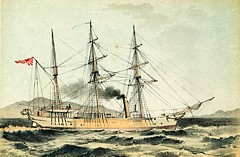Japanese sloop Hōshō
 Painting of Hōshō from 1895 book | |
| History | |
|---|---|
 Japan Japan | |
| Name | Hōshō |
| Builder | United Kingdom |
| Laid down | 1868 |
| Launched | 1868 |
| Completed | 1869 |
| Commissioned | July 4, 1871 |
| Out of service | 1898 |
| Stricken | April 19, 1906 |
| Fate | Scrapped April 9, 1907 |
| General characteristics | |
| Displacement | 321 long tons (326 t) |
| Length | 35.7 m (117 ft) |
| Beam | 7.37 m (24 ft 2 in) |
| Draught | 2.44 m (8 ft) |
| Propulsion |
|
| Speed | 11 knots (13 mph; 20 km/h) |
| Range | 810 tons charcoal |
| Complement | 65 |
| Armament |
|
Hōshō (鳳翔, Flying Phoenix) was a screw sloop, originally built in the United Kingdom for Chōshū Domain in western Japan, and subsequently served in the early Imperial Japanese Navy.
History
Hōshō was built in 1868 in Aberdeen, Scotland as a wooden-hulled three-masted bark-rigged sloop-of-war with a coal-fired triple expansion reciprocating steam engine with two boilers driving a single screw. She arrived in Japan in 1869, and was named Hōshō Maru (鳳翔 丸) by Chōshū Domain authorities. She served during the Boshin War of the Meiji Restoration, and was famous for allowing 330 Satsuma rōnin agitators to escape from Shinagawa, Edo in January 1868, despite efforts by the Tokugawa shogunate to prevent their escape. She was transferred to the fledgling Imperial Japanese Navy on May 15, 1871.
On June 8, 1871, the Meiji government renamed the vessel Hōshō . The ship was sent to support government operations during the Saga Rebellion in 1874, and was one of the ships in the Japanese fleet during the Taiwan Expedition of 1874. In 1877, Hōshō provided support to government forces during the Satsuma Rebellion.
On August 16, 1881, Hōshō was removed from frontline combat duty and was reassigned as a training vessel. During the First Sino-Japanese War, she was assigned to be a guard vessel, initially at Kure Naval Base, but later at Sasebo Naval Base. She was re-designated as a second-class gunboat on March 21, 1898, and was used for coastal patrol duties; however, she was declared obsolete and removed from service on Mar 1, 1898. It was struck from the navy list on April 19, 1906. It was scrapped on April 8, 1907.
References
- Jentschura, Hansgeorg; Jung, Dieter & Mickel, Peter (1977). Warships of the Imperial Japanese Navy, 1869–1945. Annapolis, Maryland: United States Naval Institute. ISBN 0-87021-893-X.
- Watts, A. J. (1979). "Japan". In Chesneau, Roger & Kolesnik, Eugene M. (eds.). Conway's All the World's Fighting Ships 1860–1905. Greenwich, UK: Conway Maritime Press. pp. 216–239. ISBN 0-8317-0302-4.
- v
- t
- e
- Kōtetsu 甲鉄
- Chiyodagata 千代田形
- Fujiyama 富士山
- (Transports): Chōyō Maru 朝陽
- Shōkaku Maru 翔鶴
- Kankō Maru 観光
- Hiryō Maru 飛龍
- Kanrin Maru 咸臨
- Hōō Maru 鳳凰
- Risshō Maru 立象
- Kaiun Maru 開運
- Chōgei Maru 長鯨
- Teibō No. 1 第一丁卯
- Teibō No. 2 第二丁卯
- Un'yō 雲揚
- Hōshō 鳳翔
- (Transports): Kayō Maru 華陽
- Kasuga 春日
- Kenkō 乾行
- Nisshin 日進
- Mōshun 孟春
- Ennen Maru 延年
- Denryū Maru 電流
- Ryūjō 龍驤
- Izumi Maru 和泉
- Yōshun Maru 陽春
- (Transports): Hijun Maru 飛隼
- (Transports): Kaifū Maru 快風
- (Transports): Ōsaka Maru 大坂
- Kōkyōsen 虹橋
- (Transports): Kōsoku Maru 行速
- Tsukuba 筑波
- Settsu 摂津
- Musashi 武蔵
- Kawachi 河内
- (Transports): Tōkyō Maru 東京
- Karafuto Maru 樺太









